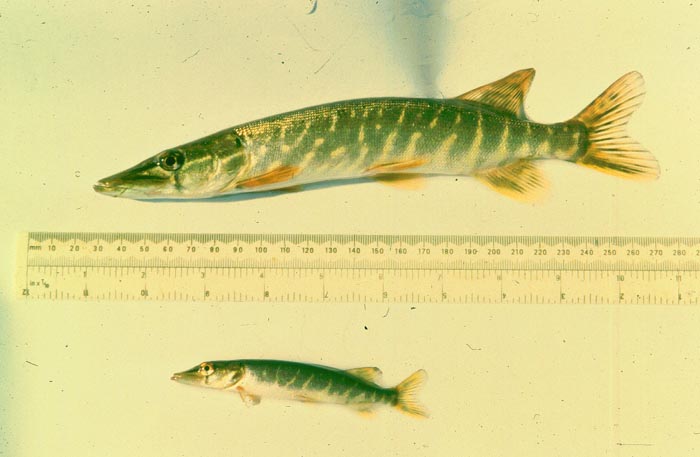
Information Page.
Golden pike
28 July 2009
I've caught a lot of pike over the years and they've been all shapes and sizes. Most of my pike fishing has been fairly conventional with lures or fish baits and I always enjoy the thrill of seeing a pike lunge from cover to take the bait. However, as many of you may be aware, for many years I carried our research on freshwater fish and in the course of this work I often had to handle, weigh, measure and tag pike. Because of the methods we were using to catch them some of these fish were much smaller than anything that I've ever caught on rod and line. The other day I was sorting through some old 35mm slides when I came across a couple that reminded me of interesting pike events.
The first slide showed two baby pike in their first year of life. These fish were caught on the same day from spots that were only a few metres apart. The implication of the catch was that the pike were of about the same age but the difference in size was huge with the larger one weighing more than eight times as much as it's small relation. The discrepancy was almost certainly due to the places in which the fish had spent the formative days since they hatched from eggs. The smaller one had remained in the cool, weedy stream where it was spawned while its relative had, at an early age, moved into the warmer main river channel where conditions and food were much more suitable for rapid growth. In fact, if the two fish had happened to meet at this point then the larger one could easily have devoured the younger specimen.
The other slide was even more remarkable. Fish, like all other animals, occasionally produce a mutant. This, of course, is the stuff of evolution. Most mutants are a serious disadvantage and are rapidly weeded out by natural selection but sometimes a mutation will mean that a species develops bigger fins, longer teeth or stronger muscles and with a bit of luck it will survive and be incorporated into the gene pool of the population. The scales and skin colour of various fish species are not exempt from change and are subject to some striking variations. This is most obvious in species such as carp where artificial breeding has produced a great range of partly scaled, scaleless and brightly coloured specimens. The same sort of thing is much less common in wild fish but for my own part I've come across dace with mirror scales, colourless minnows and piebald roach.
A fairly common mutation results in the total lack of black pigment which causes the fish to look quite yellow. This sort of thing produces golden tench, golden rudd and so on. I've even held a golden stone loach. By far the most peculiar thing I have ever seen was a golden pike from the Hampshire Avon. Despite its strikingly conspicuous colouration this fish had somehow managed to avoid the jaws of its larger relatives and had attained several pounds in weight. At the time it occurred to me that it might have been possible to breed a race of golden pike from our captive but I don't suppose they'd have gone down too well with the koi carp fanciers.
If you have any comments or questions about fish, methods, tactics or 'what have you.'get in touch with me by sending an E-MAIL to - docladle@hotmail.com
Little and large.

Golden pike.
